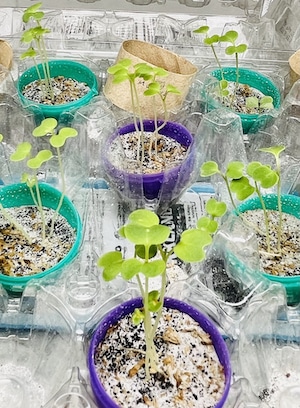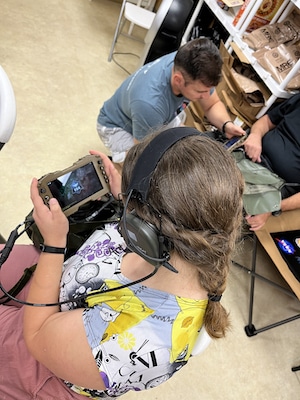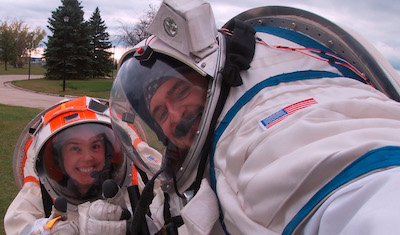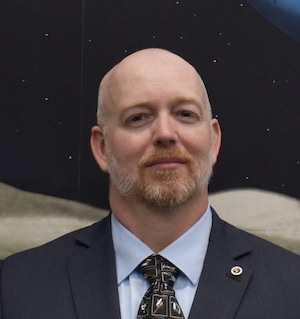By Dennis Miller
Current AMU Student, Space Studies
and Olivia Turner
Current APU Student, Management
The American Public University System Analog Research Group (AARG) is a student organization and educational program. It is driven by AMU and APU students and faculty who want to learn more about space studies and further understand human capacities and challenges humans face in outer space.
For the 5i analog mission held in October 2023, AARG members used the University of North Dakota’s (UND’s) Integrated Lunar/Mars Habitat (ILMAH) facility. ILMAH is an analog habitat used to aid in researching new technologies and methods for space crew operations.
As closely as possible on Earth, ILMAH mimics the conditions astronauts will experience during a deep space mission. For the 5i analog mission, ILMAH provided a high-fidelity environment to simulate Mars’ potential conditions and challenges. It enabled the 5i analog mission crew, consisting of AARG members, to gain experience and carry out research.
For the 5i analog mission, the IMLAH crew consisted of four people:
- Mission Commander Olivia Turner
- Mission Specialist Kailyn Cecil, current APU student, Space Studies
- Mission Specialist Luis Gonzalez, current AMU student, Space Studies
- Mission Specialist Tom DeJan, current AMU student, Space Studies
Related: AARG’s Fourth Space Analog Mission: ‘Calidum Ad Infernum’
Conducting Research during the 5i Analog Mission
Before work can be carried out in space, research and tests need to be conducted on Earth. To enable this research to be conducted, ILMAH has five modules, consisting of:
- The Core Habitation Module
- The Plant Production Module
- The Science Module
- The Extravehicular Activities (EVA) Module/Workshop
- The Exercise and Performance Module
All of these modules are designed to simulate a habitat on the Moon or Mars.
During the 5i analog mission, the crew conducted both personal and organizational research for both the University and UND. The research produced essential scientific data to help others understand the requirements for living off-world in extreme environments.
Examining Mutually Supportable Bio Systems
Carbon dioxide (CO2) is essential for plant growth and needed in photosynthesis. Ensuring that enough carbon dioxide is available for a habitat’s plants is required for long-duration missions and would allow astronauts to grow their own food.
Mission Specialist DeJan conducted a feasibility study to determine if CO2-charged water could augment the growth of hosta and tomato plants. Used water could be purified into drinking water, and the plants could become a source of Vitamin C for the operational crew. Having a direct source of fresh drinking water and the bonus of receiving vitamin C minerals is imperative on Mars, where life-sustaining resources are limited and restoring supplies would be difficult.
After daily and often multiple daily measurements of CO2 quantity [in the tank], it was determined that hosta and tomato plants produced more carbon dioxide than oxygen for any condition.” – MS DeJan

Conducting Tests with Martian Soil during the 5i Analog Mission
Another experiment involved Mission Specialist Cecil, who sought to create a self-stabilizing plant growth system that could survive on Mars. MS Cecil combined Martian regolith (a product similar to Martian soil) with a layering system topped off with Earth soil. During the experiment, there were environmental controls to aid natural microorganism growth, gas release and plant growth.
Taking part in this mission was a big step in establishing a baseline for analog research. MS Cecil’s goal was to test the established plant growth system in a climate zone that wasn’t as hot or stable as previous experiments.
Changes in the experiment’s parameters proved instrumental in driving the research further.
I learned how thinner layers could mess up the reaction of the regolith, how plants reacted to the slow mix of Earth and Mars, plus a lot more. I look forward to returning to ILMAH and participating in other analog missions.” – MS Cecil

Growing Plants in ILMAH
The ability to grow plants on Mars would be a critical component for sustaining the lives of crew members. For instance, plants commonly provide food and nutrients to crew members.
Plants can also be utilized medicinal purposes, and spending time in a plant-heavy environment provides psychological benefits for crew members’ mental well-being. The AARG-5i mission was heavy on plant research, but the crew enjoyed spending extra time in the Green Module.
CO Turner spent a lot of time in the Green Module when she was not in the gym or sitting at the tech station. She continued her research from the previous AARG-4i mission, establishing microgreens in 10 days using both Lunar and Martian regolith.

For the 5i mission, CO Turner successfully established microgreen growth in both the control and test groups of the Lunar regolith. However, she was unsuccessful in establishing any growth in either Martian regolith group.
CO Turner tested different methods to establish growth in Martian regolith and looks forward to continuing her research in future missions.
Well, it is safe to say I can definitely grow plants on the Moon!” – CO Turner
Assessing Astronaut Readiness and Fatigue during the 5i Analog Mission
MS Gonzalez set out to understand the limitations of human endurance during the 5i mission that mimicked a Martian environment. He studied astronauts’ mission accomplishment capabilities by comparing them to baseline data. In future, this research would help prevent astronaut injuries, optimize their performance, and reduce the possibility of making errors.
Baseline data measures “readiness” or how recent sleep habits and mission strain affect a crew member’s ability to perform work. It involves measuring reaction times, biometrics, and reactions to stress during off-nominal (emergency) situations.
Crew members completed a five-minute psychomotor vigilance test, which tested each crew member’s concentration endurance after conducting an EVA mission. In environments that are isolated, confined, and extreme (ICE), cognitive performance decreases, especially during long-duration missions.
Due to scheduling constraints and competing interests, MS Gonzalez was unable to further analyze test results. He hopes to further refine his research skills and submit his study for more iterations at ILMAH in the future to increase the available test subjects.
But post-EVA examinations could show that tasks requiring mental concentration after stressful or strenuous tasks performed on short-duration ICE missions can increase cognitive performance due to recent training and low fatigue buildup. MS Gonzalez collected some initial data, and there are plans to collect additional data in future missions.

I was surprised by the crew’s consistent willingness to complete each test in the morning and following any EVAs.” – MS Gonzalez
Training and Communicating for Emergencies
Effective communication is critical during an analog mission to ensure that team members work towards the same goal and maintain crew safety. For the 5i analog mission, AARG partnered with Persistent Systems to integrate and test a new communication system, consisting of Wave Relay® Mobile Ad-Hoc Networking Technology (MANET) and MPU5 radios. This technology was incorporated into the University of North Dakota’s NDX-2AT EVA suits and a Rover vehicle.
During the mission, crew members completed several tests to determine integration and function of the communication system. They tested push-to-talk functions, display controller integration, command center integration, and tracking functions.
The crew was excited to utilize this state-of-the-art communication equipment. They look forward to more partnership opportunities with Persistent Systems.


Reacting to Communication Delays during the 5i Analog Mission
Analog missions serve as a crucial testing ground for both analog astronauts and ground personnel. Introducing off-nominal scenarios during a simulated space mission like the ILMAH 5i mission provides an operational, hands-on training experience for the crew and Mission Control Center (MCC) personnel.
This type of training enables researchers to determine the crew and MCC’s reactions to emergency situations, as well as their ability to adapt, communicate, and resolve crises under pressure. During the 5i mission, the crew and MCC conducted several off-nominal (emergency) scenarios.

During one test, MCC sent a vital notification about an emergency that occurred within ILMAH. The notification had a bold red border, emphasizing the need for 5i mission members to act quickly.
For at least half the time, the crew’s communication had no delay. As a result, instant response time from both the 5i mission crew and MCC personnel was efficient.
But when the second emergency occurred, a 20-minute communication time delay was in place. Crew members experienced slightly more frustration in waiting for MCC to receive, confirm, and relay their actions to resolve the emergency as opposed to their earlier, no-delay communications. Despite the delay, the crew remained calm and swiftly completed the tasks needed to resolve the emergency.
During the second off-nominal scenario with the 20-minute communication delay, it was more than evident that thinking quickly while making good, collaborative decisions was critical to ensure the safety of the crew and the outcome of the mission. I have a newfound respect for anyone making those decisions.” – CO Turner
The 20-minute, one-way communication delay, which could occur during interplanetary communications when the Earth and Mars are at their farthest apart from one another, added an extra layer of complexity to mission simulations. Planning is essential for mission success, and it is imperative for communication plans and command authorities be developed and determined before a space mission.
Mission Control’s instructions, relayed to the crew with a 40-minute round-trip delay, forced the crew to make some decisions independently. They also had to adapt to evolving situations without immediate guidance.
This type of delay during an emergency mirrors the realities of interplanetary communication. It also demands that both the crew and mission control personnel develop exceptional communication skills. Carrying out necessary actions during emergencies in the ILMAH environment necessitates the need for good communication and provides useful feedback to improve future planning and mission directives.
Operating under a delay would make it challenging to effectively direct a team knowing that any question or clarification will require a 40-minute wait for a response.” – Flight Director Miller
Related: Valuable Communication Lessons from AARG’s 5i Analog Mission
AARG Crew Working with EVAs during the 5i Analog Mission
There are just some things that a robot cannot do. The tasks for some space missions demand human capabilities that robots currently lack.
To carry out this work, EVAs are required. Crewed EVAs are needed for scientific exploration, habitat and equipment inspection, and repairs.
Suiting up for an EVA takes considerable preparation and planning but also gives the crew the most flexibility in deciding what to do what they do outside ILMAH. Donning an EVA suit involves a learning curve, but is a true highlight of the ILMAH experience for any analog astronaut.
While wearing the suit outside the habitat and conducting a scheduled EVA, crew members felt a sense of accomplishment. However, doffing the suit is a sweaty but easy transition. By contrast, the Rover is suitable for tasks that only require observation, such as the reconnaissance of scientific sites of interest or a visual inspection of the habitat.
“Wearing a space suit was a phenomenal experience for me!” – MS Gonzalez


Why Analog Missions Are Needed
During his 1962 speech at Rice University, then-President John F. Kennedy, said, “We choose to go to the Moon in this decade and do the other things, not because they are easy, but because they are hard.”
Going to and surviving in outer space is indeed hard, due to many challenges that need to be overcome. But not every one of these challenges has an easy answer.
During analog missions, crew members run simulations and tests to try out different methods, techniques, and equipment. These simulations are run to reproduce the environment of deep space and to conduct research in a safe way that allows failure without risk to an astronaut’s life or health.
As a result, ILMAH crews can be bold in their testing, doing things that would typically not be considered by other researchers. ILMAH inhabitants push the limits to the point of failure on Earth to ensure astronaut success in outer space.
AARG is also the training ground for the next generation of space explorers. Through 5i and other analog missions, it is designed to cultivate the next space engineers, mission controllers, directors, and astronauts.
AARG members are proud to do their part in pushing the boundaries of human knowledge and exploration during an analog mission. They cannot wait to see what the future holds for space and are excited to be a part of it.
To access daily accounts of the AARG-5I mission in more detail, be sure to visit the AARG website or Facebook page. More updates can be found on Twitter, LinkedIn and Instagram.
About the Authors

Dennis Miller is a current AMU graduate student, working towards a master’s degree in space studies with a concentration in space policy. Dennis was the crew commander for mission 4i and the flight director for the 5i mission. He used 20 years of career experience from the Marine Corps to help guide planning and mission operation efforts. Dennis aspires to be a NASA mission’s flight director or program manager.

Olivia Turner is a current APU graduate student working on her master’s in management, focusing on organizational leadership. She has been an active AARG participant for the past year and has completed two simulated Martian missions in the spring and fall of 2023. Olivia enjoys learning about space and how plants grow in space, and she looks forward to learning and growing more with AARG.

Comments are closed.